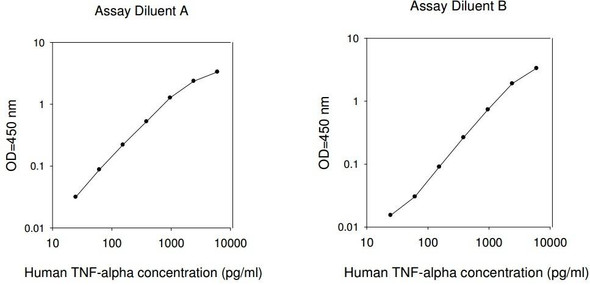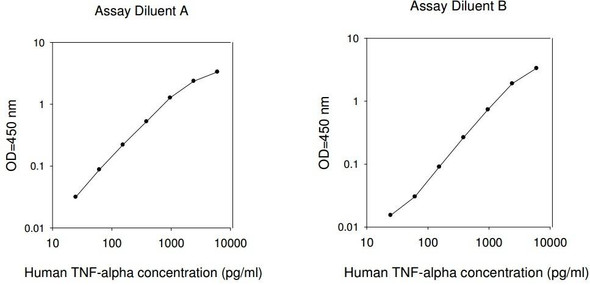Human Signal Transduction ELISA Kits
Human TACE (TNF alpha Converting Enzyme) ELISA Kit (HUES03182)
- SKU:
- HUES03182
- Product Type:
- ELISA Kit
- Size:
- 96 Assays
- Uniprot:
- P78536
- Sensitivity:
- 37.5pg/mL
- Range:
- 62.5-4000pg/mL
- ELISA Type:
- Sandwich
- Synonyms:
- ADAM metallopeptidase domain 17,ADAM17,TACE,tumor necrosis factor-alpha-converting enzyme,ADAM18, CD156B, CSVP, NISBD,
- Reactivity:
- Human
- Sample Type:
- Serum, plasma and other biological fluids
- Research Area:
- Signal Transduction
Description
| Assay type: | Sandwich |
| Format: | 96T |
| Assay time: | 4.5h |
| Reactivity: | Human |
| Detection Method: | Colormetric |
| Detection Range: | 62.50-4000 pg/mL |
| Sensitivity: | 37.50 pg/mL |
| Sample Volume Required Per Well: | 100µL |
| Sample Type: | Serum, plasma and other biological fluids |
| Specificity: | This kit recognizes Human TACE in samples. No significant cross-reactivity or interference between Human TACE and analogues was observed. |
This ELISA kit uses Sandwich-ELISA as the method. The micro ELISA plate provided in this kit has been pre-coated with an antibody specific to Human TACE. Standards or samples are added to the appropriate micro ELISA plate wells and combined with the specific antibody. Then a biotinylated detection antibody specific for Human TACE and Avidin-Horseradish Peroxidase (HRP) conjugate are added to each micro plate well successively and incubated. Free components are washed away. The substrate solution is added to each well. Only those wells that contain Human TACE, biotinylated detection antibody and Avidin-HRP conjugate will appear blue in color. The enzyme-substrate reaction is terminated by adding Stop Solution and the color turns yellow. The optical density (OD) is measured spectrophotometrically at a wavelength of 450 nm ± 2 nm. The OD value is proportional to the concentration of Human TACE. The concentration of Human TACE in samples can be calculated by comparing the OD of the samples to the standard curve.
| UniProt Protein Function: | TACE: a type I membrane protein with disintegrin and metalloprotease activity. An ubiquitously expressed ectoenzyme of peptidase family M12B. Must be membrane anchored to cleave the different substrates. The cytoplasmic domain is not required for the this activity. Possesses a narrow endopeptidase specificity. Cleaves Pro-Leu-Ala-Gln-Ala-|-Val-Arg-Ser-Ser-Ser in the membrane-bound, 26-kDa form of tumor necrosis factor alpha (TNF-alpha) to its mature soluble form. Responsible for the proteolytic release of several other cell-surface proteins, including p75 TNF-receptor, interleukin 1 receptor type II, p55 TNF-receptor, transforming growth factor-alpha, L-selectin, and the amyloid precursor protein. Also involved in the activation of Notch pathway. Binds 1 zinc ion per subunit. Two splice variant isoforms have been described. |
| UniProt Protein Details: | Protein type:Motility/polarity/chemotaxis; EC 3. 4. 24. 86; Protease; Membrane protein, integral Chromosomal Location of Human Ortholog: 2p25 Cellular Component: cell surface; focal adhesion; membrane; integral to plasma membrane; apical plasma membrane; cytoplasm; plasma membrane; intercellular junction; actin cytoskeleton; lipid raft Molecular Function:integrin binding; protein binding; interleukin-6 receptor binding; zinc ion binding; metallopeptidase activity; metalloendopeptidase activity; Notch binding; SH3 domain binding; PDZ domain binding Biological Process: extracellular matrix organization and biogenesis; nerve growth factor receptor signaling pathway; cell motility involved in cell locomotion; neutrophil mediated immunity; T cell differentiation in the thymus; response to lipopolysaccharide; positive regulation of leukocyte chemotaxis; proteolysis; G1/S-specific positive regulation of cyclin-dependent protein kinase activity; extracellular matrix disassembly; positive regulation of epidermal growth factor receptor activity; positive regulation of cell proliferation; negative regulation of interleukin-8 production; germinal center formation; cell adhesion; response to drug; spleen development; epidermal growth factor receptor signaling pathway; Notch signaling pathway; membrane protein intracellular domain proteolysis; response to high density lipoprotein stimulus; membrane protein ectodomain proteolysis; positive regulation of transforming growth factor beta receptor signaling pathway; Notch receptor processing; positive regulation of cell motility; positive regulation of cell growth; positive regulation of chemokine production; collagen catabolic process; regulation of mast cell apoptosis; PMA-inducible membrane protein ectodomain proteolysis; B cell differentiation; response to hypoxia; cell adhesion mediated by integrin; positive regulation of protein amino acid phosphorylation; negative regulation of transforming growth factor beta receptor signaling pathway; wound healing, spreading of epidermal cells; positive regulation of cell migration Disease: Inflammatory Skin And Bowel Disease, Neonatal, 1 |
| NCBI Summary: | This gene encodes a member of the ADAM (a disintegrin and metalloprotease domain) family. Members of this family are membrane-anchored proteins structurally related to snake venom disintegrins, and have been implicated in a variety of biologic processes involving cell-cell and cell-matrix interactions, including fertilization, muscle development, and neurogenesis. The protein encoded by this gene functions as a tumor necrosis factor-alpha converting enzyme; binds mitotic arrest deficient 2 protein; and also plays a prominent role in the activation of the Notch signaling pathway. [provided by RefSeq, Jul 2008] |
| UniProt Code: | P78536 |
| NCBI GenInfo Identifier: | 73747889 |
| NCBI Gene ID: | 6868 |
| NCBI Accession: | NP_003174. 3 |
| UniProt Secondary Accession: | P78536,O60226, |
| UniProt Related Accession: | P78536 |
| Molecular Weight: | 93,021 Da |
| NCBI Full Name: | disintegrin and metalloproteinase domain-containing protein 17 preproprotein |
| NCBI Synonym Full Names: | ADAM metallopeptidase domain 17 |
| NCBI Official Symbol: | ADAM17 |
| NCBI Official Synonym Symbols: | CSVP; TACE; NISBD; ADAM18; CD156B |
| NCBI Protein Information: | disintegrin and metalloproteinase domain-containing protein 17; TNF-alpha convertase; snake venom-like protease; TNF-alpha converting enzyme; ADAM metallopeptidase domain 18; tumor necrosis factor, alpha, converting enzyme |
| UniProt Protein Name: | Disintegrin and metalloproteinase domain-containing protein 17 |
| UniProt Synonym Protein Names: | Snake venom-like protease; TNF-alpha convertase; TNF-alpha-converting enzyme |
| Protein Family: | Disintegrin and metalloproteinase domain-containing protein |
| UniProt Gene Name: | ADAM17 |
| UniProt Entry Name: | ADA17_HUMAN |
As the OD values of the standard curve may vary according to the conditions of the actual assay performance (e. g. operator, pipetting technique, washing technique or temperature effects), the operator should establish a standard curve for each test. Typical standard curve and data is provided below for reference only.
| Concentration (pg/mL) | O.D | Average | Corrected |
| 4000 | 2.341 2.345 | 2.343 | 2.283 |
| 2000 | 1.559 1.619 | 1.589 | 1.529 |
| 1000 | 0.948 0.916 | 0.932 | 0.872 |
| 500 | 0.471 0.495 | 0.483 | 0.423 |
| 250 | 0.223 0.217 | 0.22 | 0.16 |
| 125 | 0.166 0.146 | 0.156 | 0.096 |
| 62.50 | 0.102 0.118 | 0.11 | 0.05 |
| 0 | 0.057 0.063 | 0.06 | -- |
Precision
Intra-assay Precision (Precision within an assay): 3 samples with low, mid range and high level Human TACE were tested 20 times on one plate, respectively.
Inter-assay Precision (Precision between assays): 3 samples with low, mid range and high level Human TACE were tested on 3 different plates, 20 replicates in each plate.
| Intra-assay Precision | Inter-assay Precision | |||||
| Sample | 1 | 2 | 3 | 1 | 2 | 3 |
| n | 20 | 20 | 20 | 20 | 20 | 20 |
| Mean (pg/mL) | 202.68 | 405.03 | 1437.11 | 219.74 | 410.66 | 1572.95 |
| Standard deviation | 11.01 | 18.63 | 45.41 | 15.27 | 22.59 | 81.79 |
| C V (%) | 5.43 | 4.60 | 3.16 | 6.95 | 5.50 | 5.20 |
Recovery
The recovery of Human TACE spiked at three different levels in samples throughout the range of the assay was evaluated in various matrices.
| Sample Type | Range (%) | Average Recovery (%) |
| Serum (n=5) | 95-106 | 100 |
| EDTA plasma (n=5) | 89-105 | 96 |
| Cell culture media (n=5) | 95-107 | 101 |
Linearity
Samples were spiked with high concentrations of Human TACE and diluted with Reference Standard & Sample Diluent to produce samples with values within the range of the assay.
| Serum (n=5) | EDTA plasma (n=5) | Cell culture media (n=5) | ||
| 1:2 | Range (%) | 88-105 | 90-102 | 95-108 |
| Average (%) | 96 | 97 | 100 | |
| 1:4 | Range (%) | 89-101 | 84-96 | 82-97 |
| Average (%) | 96 | 90 | 88 | |
| 1:8 | Range (%) | 89-103 | 85-97 | 84-98 |
| Average (%) | 94 | 90 | 90 | |
| 1:16 | Range (%) | 87-103 | 84-99 | 86-101 |
| Average (%) | 94 | 90 | 92 |
An unopened kit can be stored at 4°C for 1 month. If the kit is not used within 1 month, store the items separately according to the following conditions once the kit is received.
| Item | Specifications | Storage |
| Micro ELISA Plate(Dismountable) | 8 wells ×12 strips | -20°C, 6 months |
| Reference Standard | 2 vials | |
| Concentrated Biotinylated Detection Ab (100×) | 1 vial, 120 µL | |
| Concentrated HRP Conjugate (100×) | 1 vial, 120 µL | -20°C(shading light), 6 months |
| Reference Standard & Sample Diluent | 1 vial, 20 mL | 4°C, 6 months |
| Biotinylated Detection Ab Diluent | 1 vial, 14 mL | |
| HRP Conjugate Diluent | 1 vial, 14 mL | |
| Concentrated Wash Buffer (25×) | 1 vial, 30 mL | |
| Substrate Reagent | 1 vial, 10 mL | 4°C(shading light) |
| Stop Solution | 1 vial, 10 mL | 4°C |
| Plate Sealer | 5 pieces | |
| Product Description | 1 copy | |
| Certificate of Analysis | 1 copy |
- Set standard, test sample and control (zero) wells on the pre-coated plate and record theirpositions. It is recommended to measure each standard and sample in duplicate. Note: addall solutions to the bottom of the plate wells while avoiding contact with the well walls. Ensuresolutions do not foam when adding to the wells.
- Aliquot 100µl of standard solutions into the standard wells.
- Add 100µl of Sample / Standard dilution buffer into the control (zero) well.
- Add 100µl of properly diluted sample (serum, plasma, tissue homogenates and otherbiological fluids) into test sample wells.
- Cover the plate with the sealer provided in the kit and incubate for 90 min at 37°C.
- Aspirate the liquid from each well, do not wash. Immediately add 100µL of BiotinylatedDetection Ab working solution to each well. Cover the plate with a plate seal and gently mix. Incubate for 1 hour at 37°C.
- Aspirate or decant the solution from the plate and add 350µL of wash buffer to each welland incubate for 1-2 minutes at room temperature. Aspirate the solution from each well andclap the plate on absorbent filter paper to dry. Repeat this process 3 times. Note: a microplatewasher can be used in this step and other wash steps.
- Add 100µL of HRP Conjugate working solution to each well. Cover with a plate seal andincubate for 30 min at 37°C.
- Aspirate or decant the solution from each well. Repeat the wash process for five times asconducted in step 7.
- Add 90µL of Substrate Reagent to each well. Cover with a new plate seal and incubate forapproximately 15 min at 37°C. Protect the plate from light. Note: the reaction time can beshortened or extended according to the actual color change, but not by more than 30min.
- Add 50 µL of Stop Solution to each well. Note: Adding the stop solution should be done inthe same order as the substrate solution.
- Determine the optical density (OD value) of each well immediately with a microplate readerset at 450 nm.






